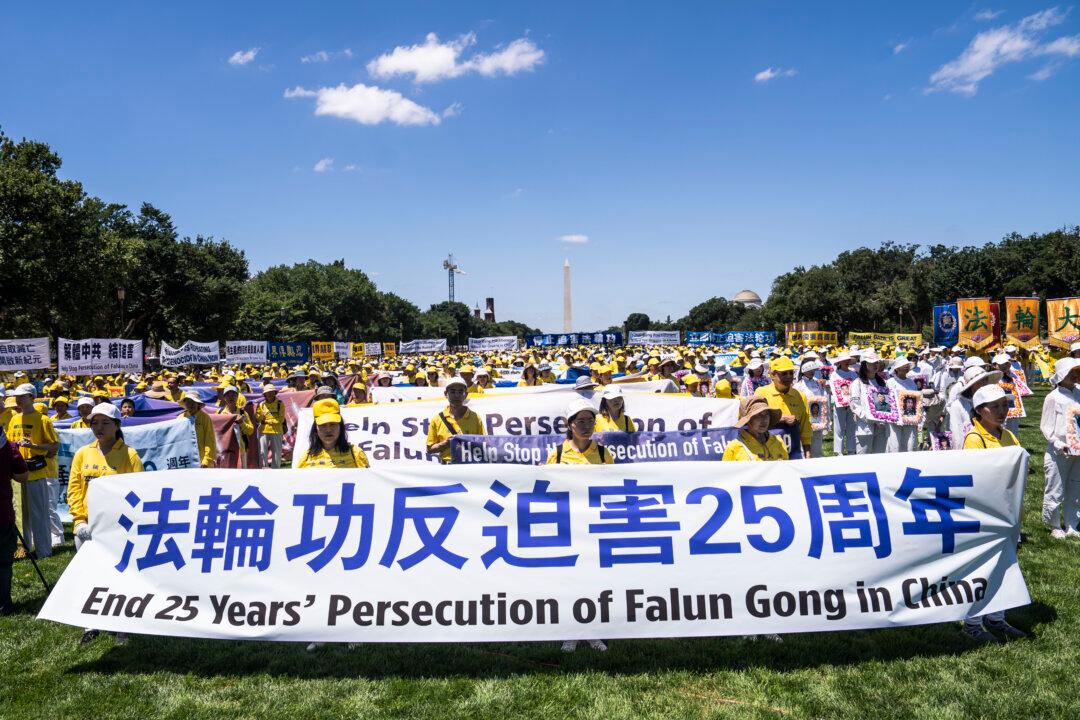As the U.S.–China rivalry extends from land and space to underwater, there are increasing signs that the United States and its allies are stepping up efforts to curb the expansion of the Chinese Communist Party’s (CCP) subsea cable projects.
Subsea cables, also known as submarine communications cables, are laid on the sea bed between land-based stations to carry telecommunication signals across stretches of ocean and sea.
Subsea cables carry 97 percent to 98 percent of the intercontinental data traffic, according to Tzeng Yisuo, associate research fellow of the Cyber Security and Decision-Making Simulation division at Taiwan’s Institute for National Defense and Security Research.
Tzeng specializes in information operations, cognitive warfare, cybersecurity governance, and emerging warfare.
Tzeng said in an interview with the Chinese-language edition of The Epoch Times that countries across the world have been exploring ways of preventing interception or eavesdropping on the information carried by subsea cables when they land on land.
The US and Allies Join Forces to Counter CCP’s Subsea Cable Projects
On June 6, the Japanese government announced a $95 million agreement signed with the United States and Australia to build a submarine cable. The planned subsea cable will connect the state of Kosrae in the Federated States of Micronesia, Tarawa in Kiribati, and Nauru to link an existing cable in Pohnpei in Micronesia.
(L–R) U.S. President Joe Biden, Australia's Prime Minister Anthony Albanese, Japan's Prime Minister Fumio Kishida, and India's Prime Minister Narendra Modi hold a Quad meeting on the sidelines of the G–7 summit, at the Grand Prince Hotel in Hiroshima, western Japan, on May 20, 2023. Jonathan Ernst/Pool Photo via AP
This 1,400-mile submarine cable project was originally put out for bidding in 2021. HMN Technologies, which is under the umbrella of China’s technology giant Huawei, also participated in the bidding, offering a price more than 20 percent lower than its competitors. However, it was delayed due to security concerns regarding potential information leaks and blockages in certain countries and was recently awarded to Japan’s NEC.
In April, Reuters revealed that China’s three major telecommunications companies were preparing to invest $500 million in building a submarine cable connecting Hong Kong to Europe, called “Europe-Middle East-Asia,” abbreviated as EMA, with the goal of competing with the SeaMeWe-6 cable being laid by U.S. company SubCom.
“SeaMeWe-6” connects Singapore to France, spanning a total length of 12,000 miles. Three major Chinese telecommunications companies were originally involved in the project and the contract was supposed to be awarded to Hengtong Optic-Electric, which owns the majority of Huawei Marine. However, under pressure from the United States, Chinese companies have been excluded, and the contract was awarded to SubCom.
Lin Tinghui, Deputy Secretary-General of the Taiwan Society of International Law, believes there is concern over content theft in submarine cable transmission lines.
He said that if the submarine cables are built by Beijing, there is a possibility of copies of data being sent to Beijing through installed filters. Under the concept of decoupling from China’s supply chain, the United States excludes Chinese companies from participating in submarine cable construction, while the CCP, under the same concept, attempts to take control of the dominant position in building its own submarine cables.
“Both sides [of the U.S. and China] have become clearly divided,” Lin told The Epoch Times on June 19.
UK Satellite Company Extends Coverage to Taiwan
Taiwan’s Minister of Digital Affairs Audrey Tang told Taiwan’s official Central News Agency (CNA) on June 16 that OneWeb, a British satellite service provider, is expected to extend its coverage to all of Taiwan by the end of this year. She also told the Taiwanese news agency that by the end of next year, the Ministry of Digital Affairs will also try its best to test mid- and low-orbit satellite equipment and study the possibility of their integrated use.This is to “ensure the operation of Taiwan’s communication networks in the event of infrastructure damage during war or emergencies,” reported CNA.
In February of this year, two submarine cables connecting Taiwan and its northern offshore Matsu Islands were cut, leaving residents of Matsu with a slow Internet connection and unstable phone service, according to Taipei Times.

A Chinese fishing boat, which landed on one of Japan's Senkaku islands, sails into Victoria Harbor in Hong Kong on November 13, 2013. Through a new system, China is militarizing its fishing ships. Aaron Tam/AFP/Getty Images
Taiwan’s Chunghwa Telecom blamed Chinese fishing vessels for the damage and said that cables connecting Taiwan proper and Matsu were broken over 20 times in the past five years.
Beijing Uses Huawei to Challenge US: Analysts
For many years, the global subsea cable business has been dominated by the three largest suppliers: U.S. subsea company SubCom LLC, Japanese firm Nippon Electric Company (NEC), and France’s Alcatel Submarine Networks (ASN).However, seeing the significant role undersea cables play in the international geopolitical arena, the Chinese communist regime entered the fiber-optic cables market to directly challenge the U.S. via its tech giant Huawei, which established a joint venture with UK-based Global Marine called Huawei Marine Networks (Huawei Marine) in 2008.
Huawei Marine’s strategy is the same as Huawei’s internet development strategy, according to Shen Rongqin, a professor at York University in Canada. Huawei Marine first looked for markets ignored by major European and American players, such as Africa, the Middle East, and Pakistan. It then captured market share at low prices through government subsidies and gradually moved from the margins to the core of the market.
Huawei initially found opportunities in the South Atlantic Inter Link (SAIL) cable project, a system that links Brazil in South America and Cameroon in Africa. To provide the incentive to the countries involved, the CCP’s Export-Import Bank provided a loan of $85 million and China’s state-owned telecommunications company China Unicom provided $34 million in financing, according to Jonathan E. Hillman in his book “The Digital Silk Road: China’s Quest to Wire the World and Win the Future.” Hillman is a senior fellow at the Center for Strategic and International Studies, an American think tank based in Washington, D.C.

Work By Huawei Marine on the 6,000-kilometer long South Atlantic Inter Link (SAIL) cable system linking Cameroon and Brazil Amindeh Blaise Atabong, Special to The Epoch Times
“Huawei Marine got its demonstration project, and Cameroon got a pile of debt,” as “demand for the project … has not materialized,” wrote Hillman in his book. Hillman said that critics believe Beijing is “using ‘debt-trap diplomacy’ to seize strategic assets.”
CCP officials often use another underwater cable project to promote Beijing’s Belt and Road Initiative. The Pakistan & East Africa Connecting Europe (PEACE) fiber-optic cable stretches from the Pakistani port of Gwadar to the African city of Djibouti, terminating in Marseille, France.
For the 8,000-mile-long PEACE, “China and Huawei purposefully chose countries with geostrategic value as intermediary landing points. Clearly, Chinese policymakers are thinking about more than just business when it comes to fiber optics,” wrote Thomas Blaubach, a graduate fellow with the cyber program at a Washington-based think tank Middle East Institute (MEI). He believes that Beijing “competes for influence against the U.S.’s military and political alliance” in these continents.
Huawei Marine has become the fourth-largest in the fiber-optic cable industry, right after the three traditional major players of SubCom LLC, NEC, and ASN.
When PEACE began construction in 2017, the communist regime’s top leader Xi Jinping put forward the concept of the “Digital Silk Road” for the first time in public, showing the CCP’s ambition to expand into the digital economy in the countries along the Belt and Road Initiative.
Shen said that the CCP has created digital conglomerates to impose stricter information control internally. He cited an earlier action taken by the CCP against Uyghur protestors in 2009 when the regime disconnected the internet completely.
In 1998, the Chinese regime set up the Great Firewall (GFW), or Golden Shield Project, which is managed by the regime’s Ministry of Public Security to monitor and censor what can and cannot be seen in China through an online network.
“Now that it is using digital totalitarianism to expand to foreign countries, [digital communications] has become the focus of the U.S.-China rivalry,” said Shen.
According to TeleGeography, a U.S. telecommunications research and consulting firm, as of early 2023, there are 552 active and planned submarine cables globally, with a total length of approximately 1.4 million kilometers, enough to circle the Earth 30 times.
With the increasing demand for network bandwidth capacity driven by streaming media, cloud computing, and 5G, submarine cables are growing at a rate of approximately 30 percent per year. In Asia alone, TeleGeography estimates that the value of submarine cable projects to be undertaken from 2023 to 2025 will reach $2.59 billion, which is six times higher than the total value since 2000, reported Nikkei Asia in May.
Lin Cenxin contributed to this report.





